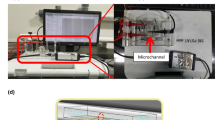Abstract
A simple mathematical model that quantitatively describes the dynamics of analyte capture in lateral flow assays is presented. The formulation accounts for the capillary-driven flow through the porous membrane, the advective transport of analyte, and the immunoreactions that take place in the detection line. Model predictions match the numerical results obtained by computer simulations of the full advection–diffusion–reaction problem in the operating regime of lateral flow assays. The main system parameters were condensed into two dimensionless numbers, namely the relative fluid velocity and the relative analyte concentration. The system is then completely characterized in the space of these critical numbers. The model is also able to describe the time evolution of analyte binding by using alternative timescalings, which discriminate different experimental conditions. The equations reported are practical tools for the design and optimization lateral flow tests, enabling informed decisions on basic questions such as the appropriate flow rate, sample volume, or assay time. Beyond lateral flow assays, the work offers an improved understanding of the underlying physicochemical processes involved in paper-based microfluidics.






Similar content being viewed by others
References
Aguirre A, Kler PA, Berli CL, Collins SE (2014) Design and operational limits of an ATR-FTIR spectroscopic microreactor for investigating reactions at liquid–solid interface. Chem Eng J 243:197–206
Ayachit U (2015) The paraview guide: a parallel visualization application
Cate DM, Adkins JA, Mettakoonpitak J, Henry CS (2015) Recent developments in paper-based microfluidic devices. Anal Chem 87(1):19–41
Choi JR, Liu Z, Hu J, Tang R, Gong Y, Feng S, Ren H, Wen T, Yang H, Qu Z et al (2016) Polydimethylsiloxane-paper hybrid lateral flow assay for highly sensitive point-of-care nucleic acid testing. Anal Chem. doi:10.1021/acs.analchem.6b0195
Donea J, Huerta A (2003) Finite element methods for flow problems. Wiley Online Library, New York
Elizalde E, Urteaga R, Berli CL (2015) Rational design of capillary-driven flows for paper-based microfluidics. Lab Chip 15(10):2173–2180
Gervais T, Jensen KF (2006) Mass transport and surface reactions in microfluidic systems. Chem Eng Sci 61(4):1102–1121
Hansen R, Bruus H, Callisen TH, Hassager O (2012) Transient convection, diffusion, and adsorption in surface-based biosensors. Langmuir 28(19):7557–7563
Hu G, Gao Y, Sherman PM, Li D (2005) A microfluidic chip for heterogeneous immunoassay using electrokinetical control. Microfluid Nanofluid 1(4):346–355
Jahanshahi-Anbuhi S, Chavan P, Sicard C, Leung V, Hossain SZ, Pelton R, Brennan JD, Filipe CD (2012) Creating fast flow channels in paper fluidic devices to control timing of sequential reactions. Lab Chip 12(23):5079–5085
Kler PA, Berli CL, Guarnieri FA (2011) Modeling and high performance simulation of electrophoretic techniques in microfluidic chips. Microfluid Nanofluid 10(1):187–198
Kler PA, Dalcin LD, Paz RR, Tezduyar TE (2013) SUPG and discontinuity-capturing methods for coupled fluid mechanics and electrochemical transport problems. Comput Mech 51(2):171–185
Kockmann N (2008) Transport phenomena in micro process engineering. Springer Science & Business Media, Berlin
Mace CR, Deraney RN (2014) Manufacturing prototypes for paper-based diagnostic devices. Microfluid Nanofluid 16(5):801–809
Masoodi R, Pillai KM (2010) Darcy’s law-based model for wicking in paper-like swelling porous media. AIChE J 56(9):2257–2267
Mendez S, Fenton EM, Gallegos GR, Petsev DN, Sibbett SS, Stone HA, Zhang Y, López GP (2009) Imbibition in porous membranes of complex shape: quasi-stationary flow in thin rectangular segments. Langmuir 26(2):1380–1385
Moghadam BY, Connelly KT, Posner JD (2015) Two orders of magnitude improvement in detection limit of lateral flow assays using isotachophoresis. Anal Chem 87(2):1009–1017
Parolo C, Medina-Sánchez M, de la Escosura-Muñiz A, Merkoçi A (2013) Simple paper architecture modifications lead to enhanced sensitivity in nanoparticle based lateral flow immunoassays. Lab Chip 13(3):386–390
Parsa H, Chin CD, Mongkolwisetwara P, Lee BW, Wang JJ, Sia SK (2008) Effect of volume-and time-based constraints on capture of analytes in microfluidic heterogeneous immunoassays. Lab Chip 8(12):2062–2070
Qian S, Bau HH (2003) A mathematical model of lateral flow bioreactions applied to sandwich assays. Anal Biochem 322(1):89–98
Qian S, Bau HH (2004) Analysis of lateral flow biodetectors: competitive format. Anal Biochem 326(2):211–224
Ragavendar M, Anmol CM (2012) A mathematical model to predict the optimal test line location and sample volume for lateral flow immunoassays. In: Engineering in Medicine and Biology Society (EMBC). IEEE, pp 2408–2411
Shin JH, Park J, Kim SH, Park JK (2014) Programmed sample delivery on a pressurized paper. Biomicrofluidics 8(5):054,121
Shou D, Fan J (2015) Structural optimization of porous media for fast and controlled capillary flows. Phys Rev E 91(5):053,021–6
Squires TM, Messinger RJ, Manalis SR (2008) Making it stick: convection, reaction and diffusion in surface-based biosensors. Nat Biotechnol 26(4):417–426
van der Walt S, Colbert S, Varoquaux G (2011) The NumPy array: a structure for efficient numerical computation. Comput Sci Eng 13(1):22–30
Wang X, Hagen JA, Papautsky I (2013) Paper pump for passive and programmable transport. Biomicrofluidics 7(1):014,107–11
Wong R, Tse H (eds) (2009) Lateral flow immunoassay. Humana Press, New York
Yager P, Edwards T, Fu E, Helton K, Nelson K, Tam MR, Weigl BH (2006) Microfluidic diagnostic technologies for global public health. Nature 442(7101):412–418
Yetisen AK, Akram MS, Lowe CR (2013) Paper-based microfluidic point-of-care diagnostic devices. Lab Chip 13(12):2210–2251
Zeng N, Wang Z, Li Y, Du M, Liu X (2012) Identification of nonlinear lateral flow immunoassay state-space models via particle filter approach. IEEE Trans Nanotechnol 11(2):321–327
Acknowledgments
The authors acknowledge the financial support from the Consejo Nacional de Investigaciones Científicas y Técnicas, CONICET (PIP-0363), and the Universidad Nacional del Litoral, UNL (CAI+D-78-5012011010010-0).
Author information
Authors and Affiliations
Corresponding author
Rights and permissions
About this article
Cite this article
Berli, C.L.A., Kler, P.A. A quantitative model for lateral flow assays. Microfluid Nanofluid 20, 104 (2016). https://doi.org/10.1007/s10404-016-1771-9
Received:
Accepted:
Published:
DOI: https://doi.org/10.1007/s10404-016-1771-9




